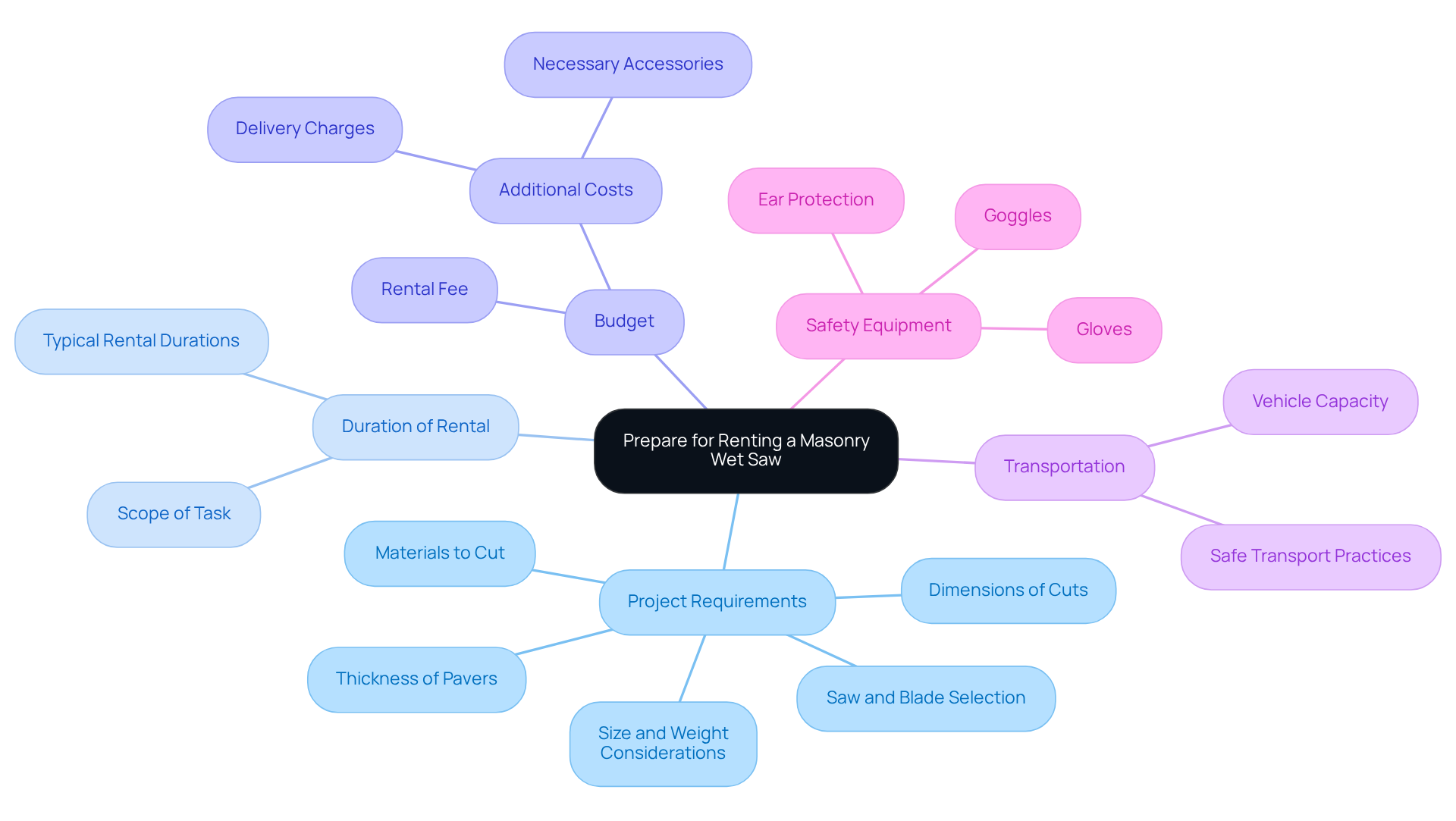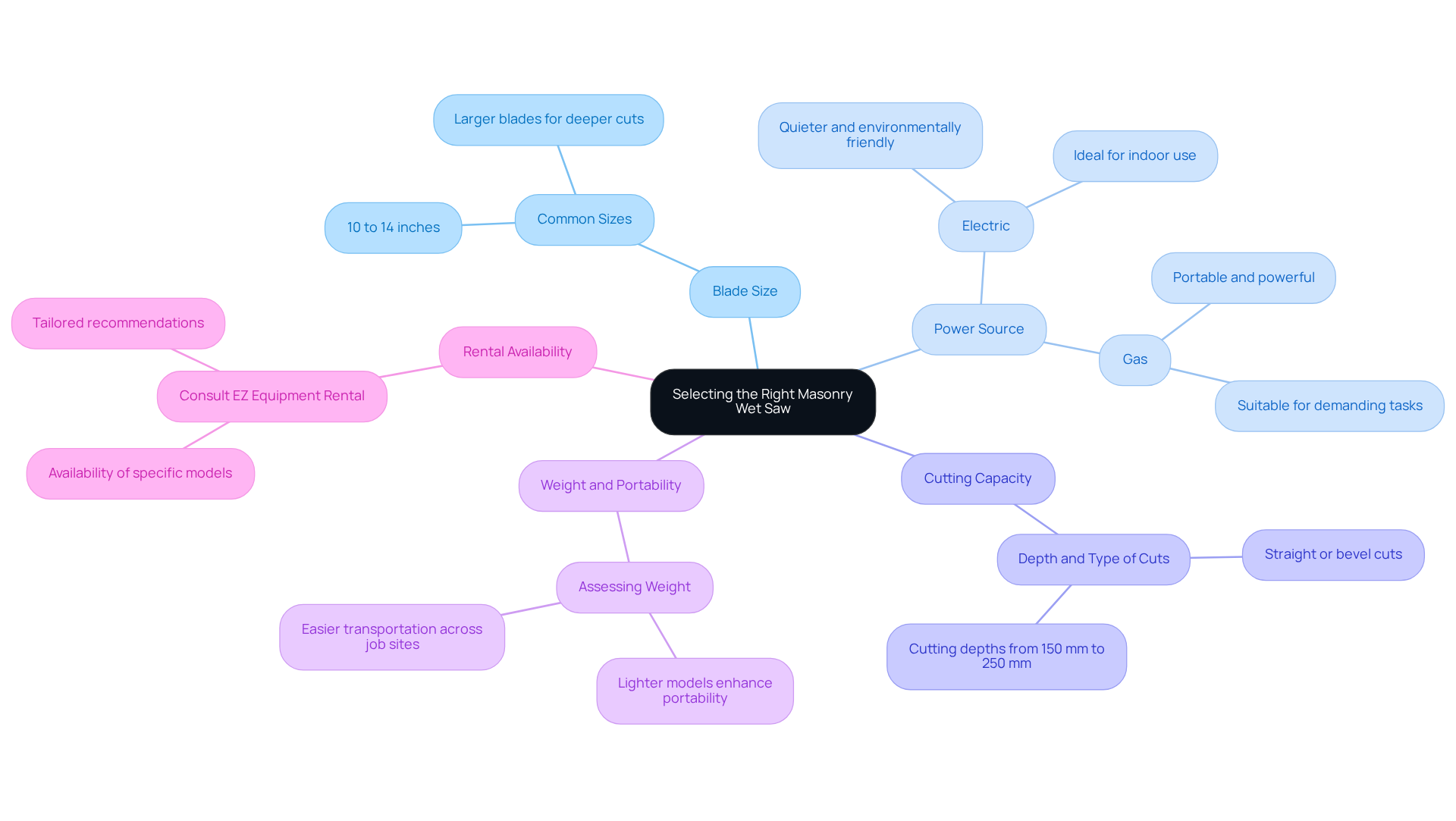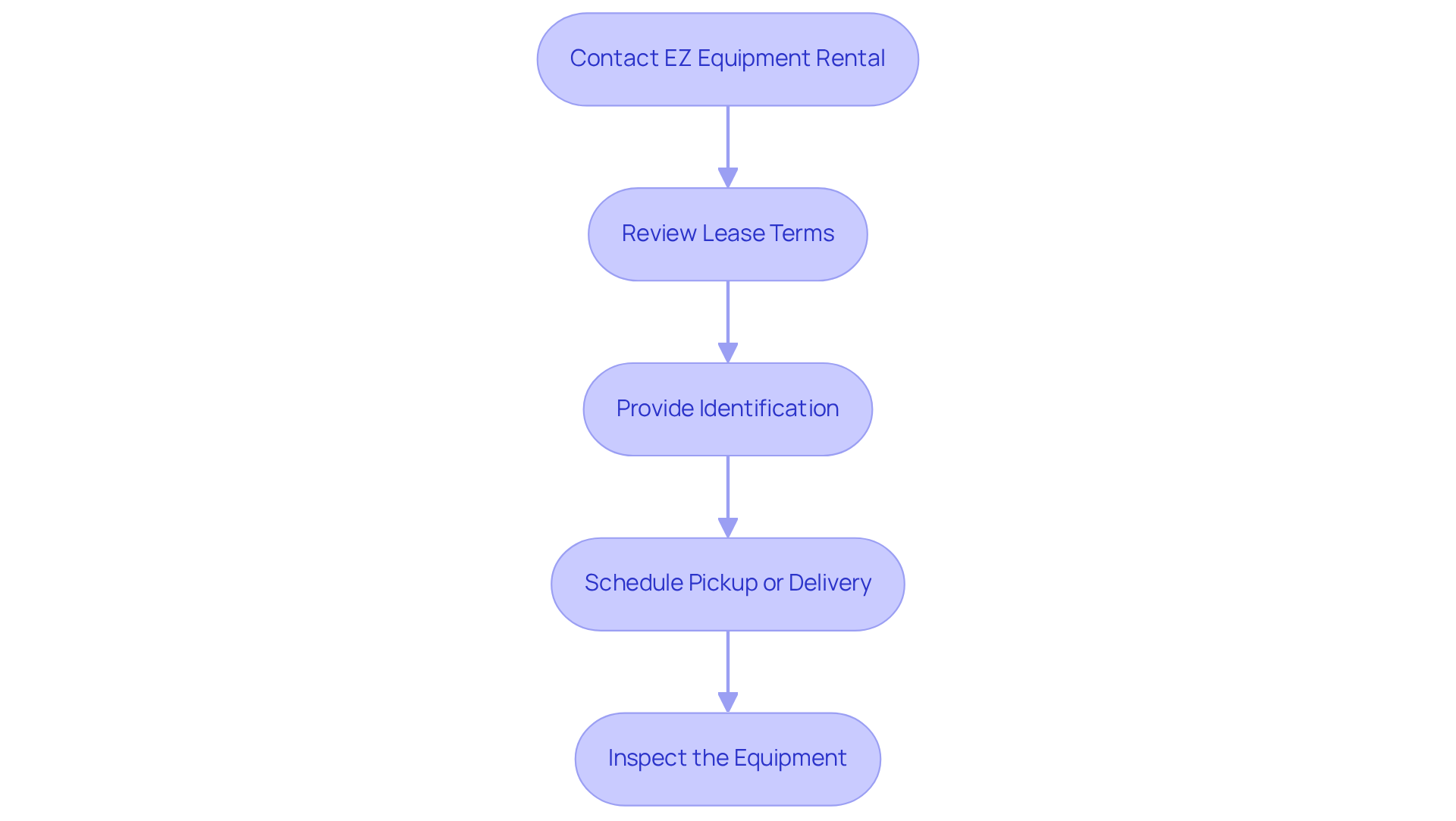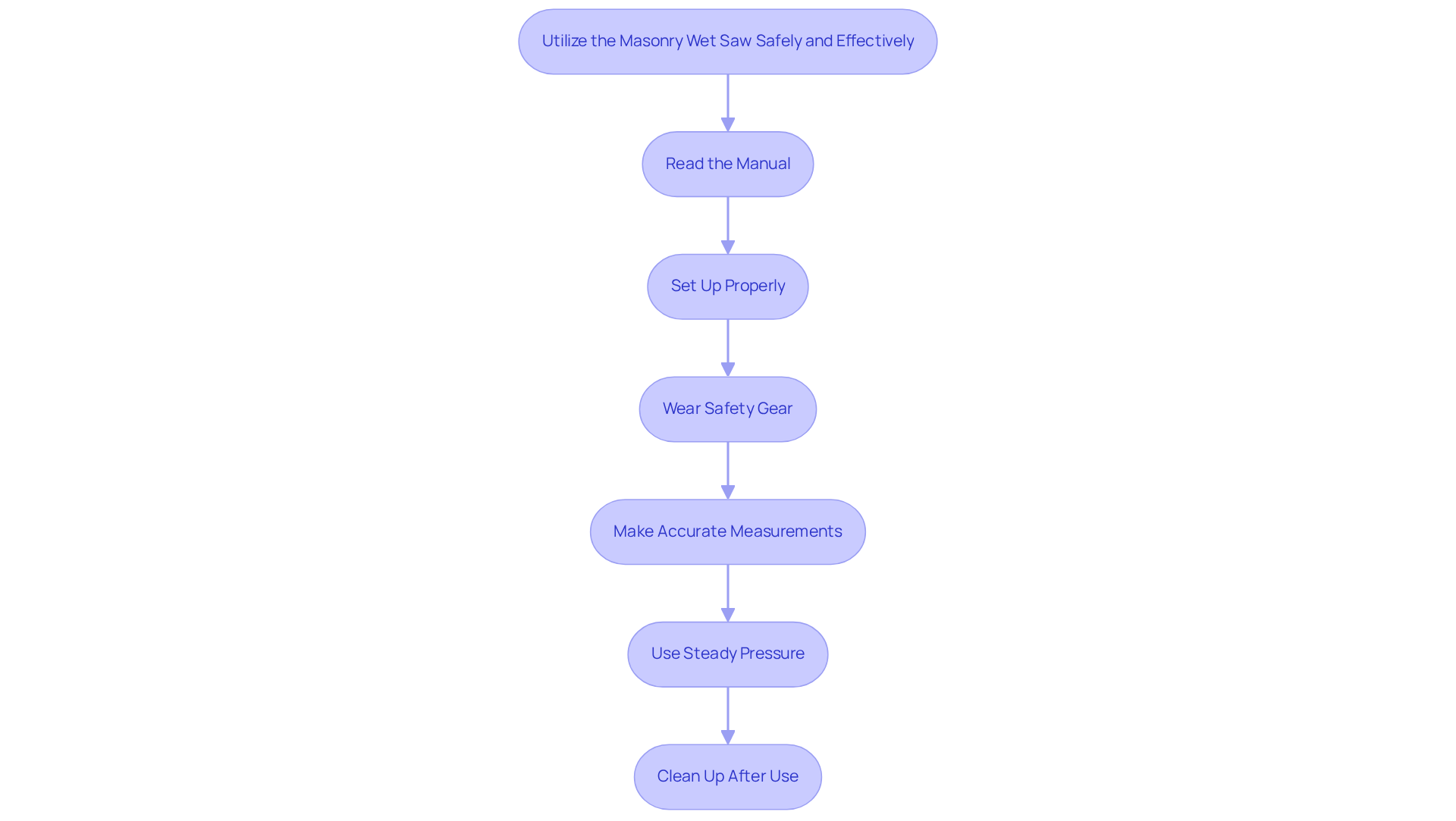Overview
The four steps for successful masonry wet saw rental are crucial for ensuring a seamless experience.
- Defining project requirements allows you to select the right equipment tailored to your specific needs.
- Determining rental duration and budget ensures that you maximize value while keeping costs in check.
- Planning transportation logistics is essential for the timely delivery and return of the equipment.
- Gathering essential safety equipment is paramount to uphold safety standards on the job site.
Each of these steps contributes significantly to a smooth rental experience, underscoring the importance of preparation and safety for effective use of the equipment in masonry projects.
Key Highlights:
- Define project requirements, including material type, thickness, and cut dimensions to select the right saw and blade.
- Determine the duration of rental, which typically ranges from a few hours to several days in the DFW region.
- Establish a budget that includes rental fees and potential additional costs like delivery and accessories.
- Ensure transportation logistics are planned to safely move the wet saw to the job site.
- Gather essential safety equipment, including goggles, gloves, and ear protection, for a secure working environment.
- Choose the right blade size based on material thickness, with common sizes ranging from 10 to 14 inches.
- Decide on a power source, opting for electric saws for indoor use and gas-powered models for portability.
- Confirm the cutting capacity of the saw for the required depth and type of cuts needed.
- Consult with EZ Equipment Rental for availability and tailored recommendations based on project needs.
- Follow essential rental steps: confirm availability, review lease terms, provide ID, arrange pickup or delivery, and inspect the equipment.
- Adhere to safety guidelines: read the manual, set up properly, wear safety gear, make accurate measurements, apply steady pressure, and clean up after use.
Introduction
Navigating the world of masonry projects can indeed seem daunting, particularly when it comes to selecting the right tools for the job. Among these tools, the masonry wet saw is an essential piece of equipment, crucial for achieving precise cuts in various materials. This guide provides a comprehensive overview of the critical steps involved in successfully renting a masonry wet saw—from preparing for the rental to ensuring safe and effective operation. Furthermore, it addresses potential challenges that may arise during this process and offers insights on how to avoid common pitfalls that could derail your project.
Prepare for Renting a Masonry Wet Saw
To ensure a seamless rental experience for a masonry wet saw, it is crucial to gather the following information in advance:
- Project Requirements: Clearly define the materials you will be cutting, including the thickness of the pavers and the dimensions of the cuts needed. This clarity aids in selecting the appropriate saw and diamond blade, as understanding the material of the pavers is essential for choosing the right blade to achieve optimal cutting results. Furthermore, consider the size and weight of the wet saw to ensure it meets your specific requirements.
- Duration of Rental: Evaluate how long you will need the wet saw. In the DFW region, average rental durations typically range from a few hours to several days, depending on the scope of the task.
- Budget: Develop a budget that includes the rental fee and any potential additional costs, such as delivery charges or necessary accessories. is dedicated to providing transparent pricing, with options starting at competitive rates, ensuring you receive the best value for your investment.
- Transportation: Reflect on how you will transport the wet saw to your job site. Ensure your vehicle can safely accommodate the equipment, as improper transportation can lead to damage or safety hazards.
- Safety Equipment: Assemble essential safety equipment, including goggles, gloves, and ear protection, to maintain a secure working environment during your project.
By organizing these elements in advance and leveraging the expert advice and support services at EZ Equipment Rental, you will streamline the process of masonry wet saw rental and ensure you have everything necessary for a successful masonry project.

Select the Right Masonry Wet Saw
Selecting the right masonry wet saw rental requires careful consideration of several key factors that can significantly impact your work efficiency.
- Blade Size: Choose a blade size that aligns with the thickness of the materials you intend to cut. Common sizes range from 10 to 14 inches, with larger blades designed for deeper cuts, ensuring optimal performance.
- Power Source: Decide between electric and gas-powered tools based on your location and access to power sources. Electric saws are quieter and more environmentally friendly, making them ideal for indoor use. Conversely, gas-powered models provide the portability and power necessary for demanding tasks.
- Cutting Capacity: Verify that the saw can accommodate the required depth and type of cuts, such as straight or bevel cuts. Models capable of achieving cutting depths from 150 mm to 250 mm captured a 43.20% market share in 2024, showcasing their versatility and adaptability for various tasks.
- Weight and Portability: Assess the saw's weight, particularly if frequent movement is needed. Lighter models enhance portability, making transportation across job sites significantly easier.
- Rental Availability: Consult with EZ Equipment Rental regarding the availability of specific models. Their experienced team can provide tailored recommendations based on your requirements and current inventory.
In the words of a representative from Walser Contracting Ltd., "Using a diamond blade on a concrete saw offers exceptional durability and superior cutting performance, making it the preferred choice for cutting rigid materials like concrete." By evaluating these factors, you can select a masonry wet saw rental that maximizes efficiency and effectiveness for your building tasks.

Complete the Rental Process
To successfully complete the rental process for a masonry wet saw, follow these essential steps:
- Contact EZ Equipment Rental to confirm the availability of your chosen masonry wet saw rental. Their knowledgeable team stands ready to assist you in finding the right equipment for your project.
- Review Lease Terms: Thoroughly examine the lease agreement, paying close attention to the duration, associated fees, and any potential charges for late returns or damages. Grasping these terms is essential; ineffective quote and invoice procedures can lead to frustration, as noted by software strategist Nathan Crossley.
- Provide Identification: Be prepared to show a valid ID and possibly a credit card for security reasons during the leasing process.
- For your project, consider a masonry wet saw rental. Schedule pickup or delivery for your masonry wet saw rental: Decide whether you will pick up the saw or require delivery to your project site, and confirm the logistics with EZ Equipment Rental. They offer flexible options to meet your needs, with store hours from Monday to Friday, 7:30 AM to 5:30 PM, and Saturday from 7:30 AM to 5:00 PM, ensuring easy access to your equipment.
- Inspect the Equipment: Upon receiving the saw, examine it for any damages or issues before signing the lease agreement. Report any concerns immediately to avoid liability.
By adhering to these steps, you can ensure a smooth rental process and minimize the risk of misunderstandings.

Utilize the Masonry Wet Saw Safely and Effectively
To utilize the masonry wet saw safely and effectively, adhere to the following guidelines:
- Read the Manual: Familiarize yourself with the manufacturer's instructions and safety guidelines before operating the saw. Understanding the equipment is crucial for preventing accidents and ensuring proper use.
- Set Up Properly: Ensure the saw is positioned on a stable surface, and all safety guards are in place before use. This setup minimizes the risk of kick-back and other hazards associated with improper installation.
- Wear Safety Gear: Always wear appropriate safety gear, including goggles, gloves, and ear protection. This gear is essential for protecting against potential injuries from dust, debris, and noise during operation. Remember, Cal/OSHA requires dust reduction systems for powered tools or equipment to cut, grind, core, or drill concrete or masonry materials.
- Make Accurate Measurements: Measure and mark your cuts clearly to ensure precision and avoid mistakes. Accurate measurements help prevent crooked cuts that can lead to blade pinching or loss of control.
- Use Steady Pressure: When cutting, apply steady pressure without forcing the saw. Allow the blade to do the work, which reduces the risk of kick-back and ensures a cleaner cut. Avoid distractions while operating tools, as this can lead to accidents.
- Clean Up After Use: After completing your cuts, clean the saw and the work area. This practice not only maintains safety but also prolongs the equipment's lifespan by preventing dust build-up. Training on health hazards of dust must be conducted at least annually to ensure all workers are aware of the risks.
By following these guidelines, you can ensure that your use of the masonry wet saw rental is both safe and effective, leading to successful project outcomes. Remember, proper training and adherence to safety measures are vital in preventing injuries and ensuring a productive work environment.

Conclusion
Renting a masonry wet saw can be a straightforward process when approached with the right preparation and knowledge. Understanding the essential steps involved—from determining project requirements to selecting the appropriate saw and ensuring safe usage—is crucial for achieving successful outcomes. The key takeaway is that thorough planning and informed decision-making are critical to maximizing efficiency and safety.
Several important factors must be highlighted, including:
- Define project specifics
- Select the right blade size and power source
- Complete the rental process with care
Each of these elements plays a crucial role in ensuring that the chosen equipment meets the demands of the task at hand while safeguarding the user against potential hazards.
Ultimately, the benefits of renting a masonry wet saw extend beyond mere convenience; they encompass enhanced productivity and safety on the job site. By adhering to the outlined guidelines and embracing best practices in equipment selection and usage, individuals can elevate their masonry projects to new heights. Embrace the opportunity to learn and prepare effectively, and transform your next masonry endeavor into a resounding success.
Frequently Asked Questions
What information should I gather before renting a masonry wet saw?
You should gather information about your project requirements, including the materials you will be cutting, their thickness, and the dimensions of the cuts needed. Additionally, consider the duration of the rental, your budget, transportation options, and necessary safety equipment.
How do I determine the right masonry wet saw for my project?
Clearly define the materials you will be cutting and their thickness, as well as the dimensions of the cuts needed. This information will help you select the appropriate saw and diamond blade, ensuring optimal cutting results.
What is the typical rental duration for a masonry wet saw in the DFW region?
Rental durations typically range from a few hours to several days, depending on the scope of your task.
What should I include in my budget for renting a masonry wet saw?
Your budget should include the rental fee and any potential additional costs, such as delivery charges or necessary accessories.
How can I ensure safe transportation of the wet saw to my job site?
Ensure that your vehicle can safely accommodate the wet saw to prevent damage or safety hazards during transportation.
What safety equipment should I have when using a masonry wet saw?
Essential safety equipment includes goggles, gloves, and ear protection to maintain a secure working environment during your project.
How can EZ Equipment Rental assist in the masonry wet saw rental process?
EZ Equipment Rental offers expert advice and support services to help streamline the rental process and ensure you have everything necessary for a successful masonry project.




